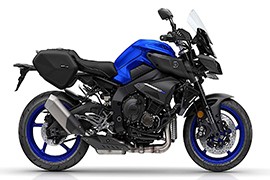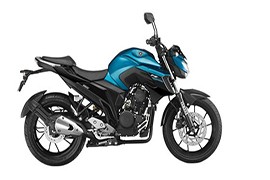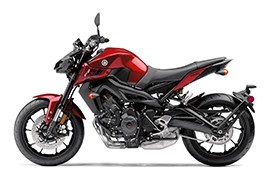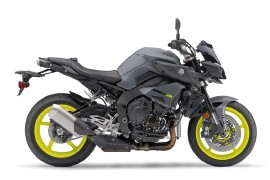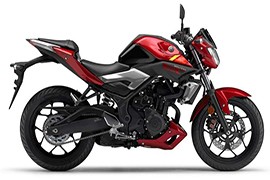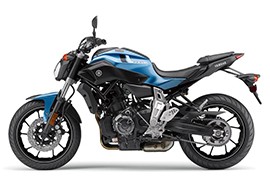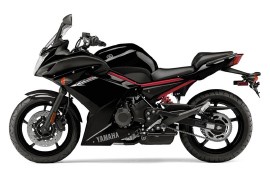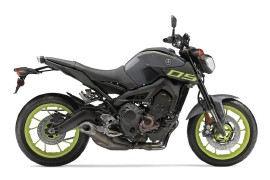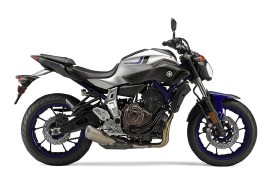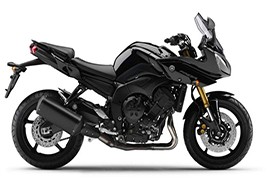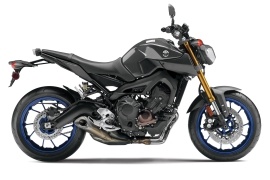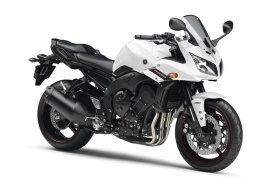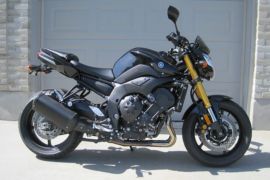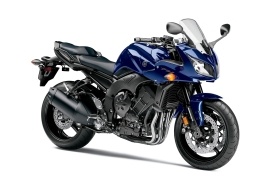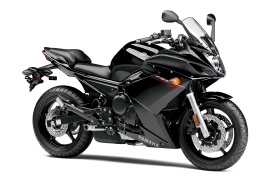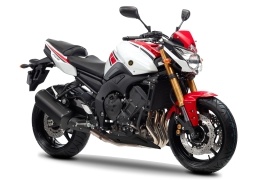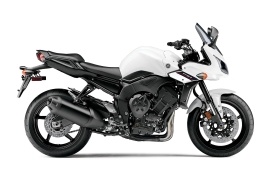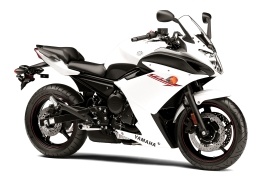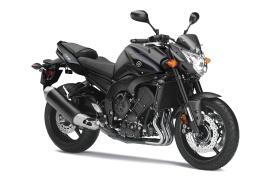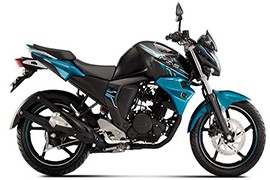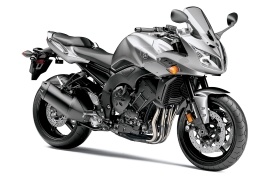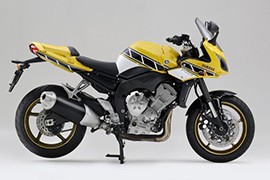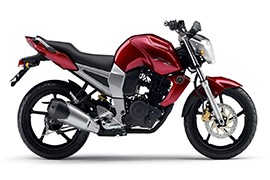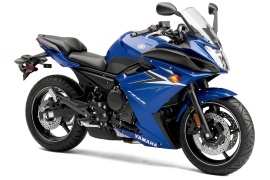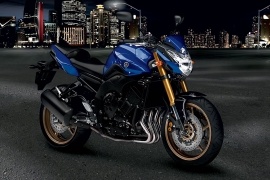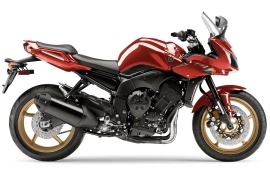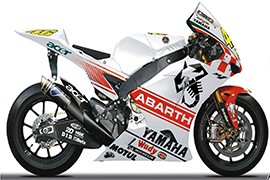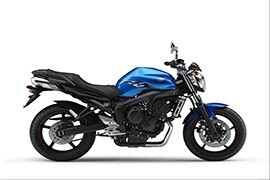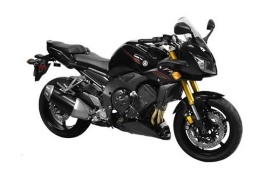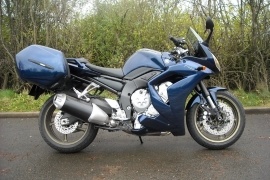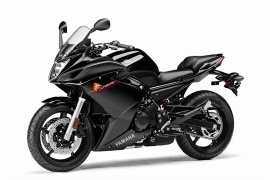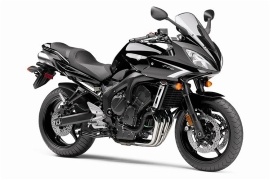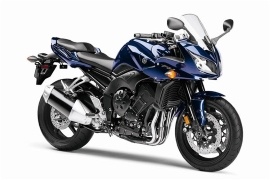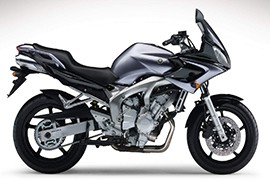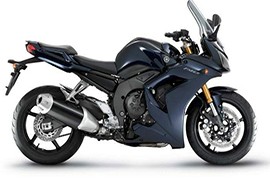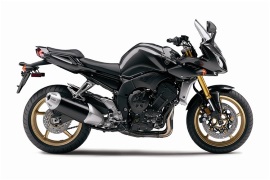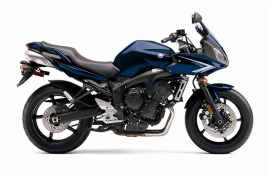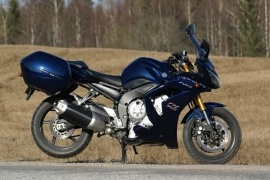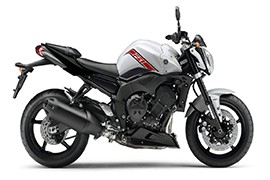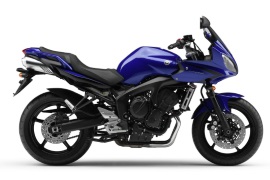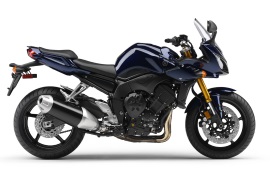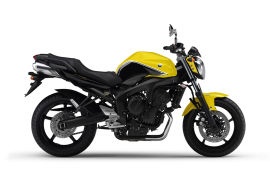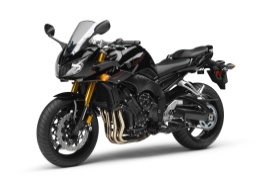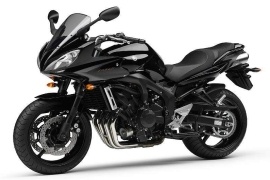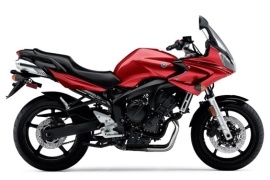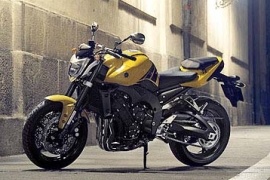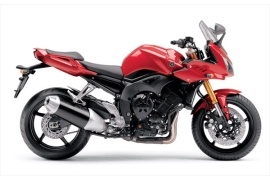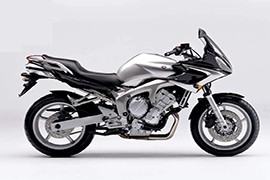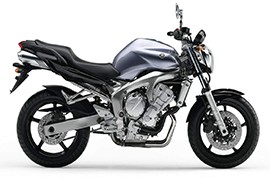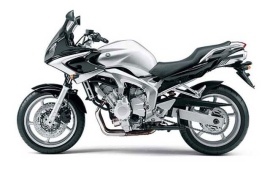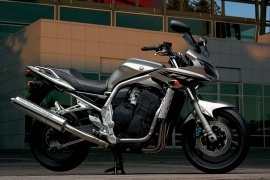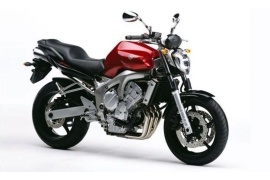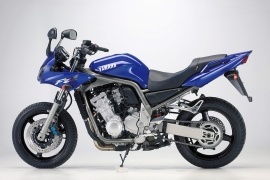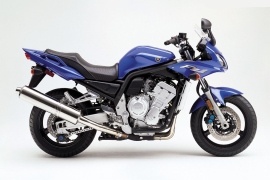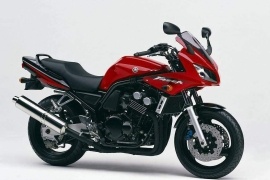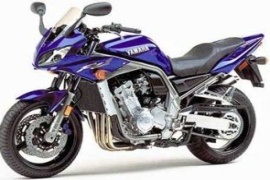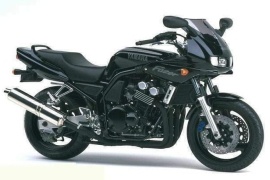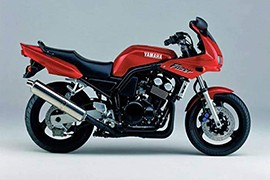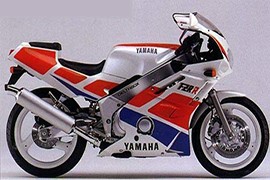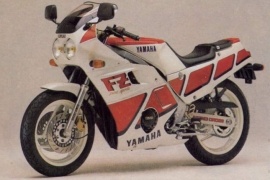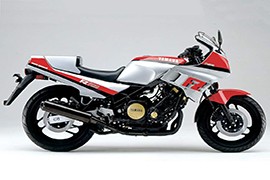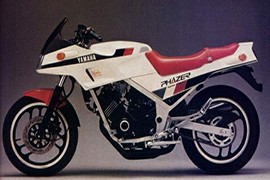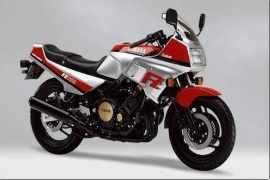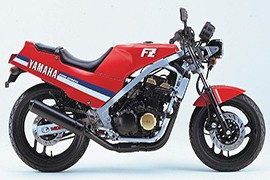YAMAHA FZ Models/Series Timeline, Specifications & Photos
First production year: 1984
The Yamaha FZ-10, also named MT-10, was a standard or naked machine manufactured by Yamaha in 2016. The bike was first presented at the 2015 EICMA Show in Milan, Italy, and was the flagship model of the FZ series.
The bike was powered by a cross-plane engine derived from the YZF-R1 machine, retuned for low-mid torque. Also, they had several significant changes, such as newly designed intake, exhaust, and fuel systems.
Besides the standard FZ-10 machine, the Japanese maker released the Yamaha FZ-10 Tourer, equipped with touring accessories, such as a tall windscreen for better wind protection, knuckle guards, a redesigned seat for more comfort, and medium-sized saddlebags.
Instead of buying the touring parts and accessories separately, the Yamaha FZ-10 Tourer was fully equipped right from the factory, saving riders considerable money.
The bike was built on a Deltabox aluminum frame with a 43 mm telescopic fork on the front that offered 120 mm wheel travel and a shock absorber on the rear with 120 mm wheel travel, providing reliable suspension performance and handling.
For brakes, the Yamaha FZ-10 Tourer was fitted with two 320 mm discs squeezed by four-piston calipers on the front wheel and a 220 mm disc engaged by a single-piston caliper on the rear wheel, offering strong stopping power.
As for the power figures, the 2017 Yamaha FZ-10 Tourer made use of a 998cc transverse-mounted four-cylinder liquid-cooled engine, boasting 160 hp at 11,500 rpm and 111 Nm (82 lb-ft) torque at 9,000 rpm.
In 2017, the Japanese motorcycle manufacturer launched the Yamaha FZ25, a small-displacement naked motorcycle. The bike was a 250cc derivate of the FZ series, aimed at existing owners, and sold in the Brazilian market under the Fazer 250 designation.
In a test conducted by "MotorBeam," the bike proved to be a versatile machine with smooth performance and excellent engine refinement. In 2019, the maker introduced the third generation of the FZ and FZ-S motorcycles in India.
In the visual department, the bike had standard features, such as a single headlight unit integrated into a small cowl, a small wind deflector, a two-piece dual seat with passenger grab rails, a single exhaust system mounted on the right side, and 10-spoke lightweight wheels.
The bike was built around a diamond frame, with a telescopic fork and a single brake disc on the front and a single shock absorber on the rear with a single brake disc on the rear, handling the bike's suspension and stopping power.
The 2017 Yamaha FZ25 had its soul brought to life by a 249cc four-stroke air-cooled single-cylinder engine managed by an electronically controlled fuel injection system, delivering 21 hp with a peak force at 8,000 rpm and 20 Nm (15 lb-ft) torque at 6,000 rpm.
The power produced by the small engine was transferred to a five-speed manual transmission with a wet multi-plate clutch and sent to the rear wheel through a final chain drive.
In 2017, Yamaha launched the FZ-09, a street motorcycle also known as the MT-09 that debuted in 2014. The FZ-09 machine was powered by an 847cc Three-cylinder powerplant mounted in a lightweight aluminum frame.
The bike was presented at the 2016 INTERMOT Motorcycle Show and came with a vast list of changes for the 2017 model year. Also, the machine was famous for its naked and supermotard elements combined together.
The long list of modifications included the Anti-Lock Braking System (ABS), a twin headlight design with four LED globes, and a revised fully-adjustable suspension system, offering excellent handling.
The bike came equipped from the factory with a one-piece dual seat, a large air scoop, a rear fender with a single forged aluminum arm, an Assist and Slipper (A&S) clutch, a Quick Shift System (QSS) that offered smooth shifting, and ten-spoke wheels.
In the suspension department, the 2017 Yamaha FZ-09 was equipped with a fully-adjustable 41 mm inverted telescopic fork on the front and a preload and rebound adjustable shock absorber on the rear.
In the performance department, the bike packed an 847cc four-stroke liquid-cooled three-cylinder engine capable of delivering an output power of 115 hp with a peak at 10,000 rpm and 88 Nm (65 lb-ft) torque at 8,500 rpm.
The engine was paired with a six-speed manual transmission, taking the engine power and sending it to the rear wheel through a final chain drive, pushing the bike to a top speed of 210 kph (130 mph).
The Yamaha FZ-10 was a standard motorcycle part of the FZ series that comprised motorcycles of different displacements with various shapes and sizes. The bike, also known as the Yamaha MT-10, was presented at the 2015 EICMA in Milan, Italy.
The bike was first sold in 2016 and was the flagship model of the FZ series in Yamaha's range. It was powered by a 2015 YZF-R1-derived engine with a cross-plane crankshaft design tuned to deliver low-mid torque.
Also, the bike came with several significant changes, which included newly designed intake, exhaust, and fuelling systems. Although the motorcycle featured V-Max-type air vents, those were simply for design without any functionality.
Also, in 2016, the Japanese maker made the Yamaha MT-10 SP available only for the European market, which packed some modifications, such as YZF-R1M-derived Ohlins electronic suspension, a full-color TFT LCD instrument cluster, and an exclusive livery.
In 2017, Yamaha released the FZ-10 machine with a mechanical design, a single-piece dual seat with small pillion grab rails, an up-swept exhaust system, a small dual headlight layout, and five-spoke lightweight wheels.
For power, the 2017 Yamaha FZ-10 had a 998cc four-stroke four-cylinder liquid-cooled engine, capable of delivering a power output of 160 hp with peak force at 11,500 rpm and 111 Nm (82 lb-ft) torque at 9,000 rpm.
As for braking performance, the machine was fitted with four-piston calipers and two 320 mm discs on the front and a single-piston caliper with a 220 mm disc on the rear, providing strong and reliable stopping power.
In 2006, Yamaha released the MT-03, a naked or Universal Japanese Motorcycle (UJM), also known as the FZ-03, that featured a 659cc single-cylinder engine derived from the Yamaha XT660R machine.
Yamaha reintroduced the MT-03 motorcycle in 2016, still a naked machine that came with a completely new 320cc parallel-twin engine and a six-speed manual transmission. The bike was based on the Yamaha YZF-R3 sports motorcycle.
In 2019, Yamaha presented the new 2020 Yamaha MT-03 motorcycle with several changes and upgrades. Some modifications included an inverted front fork and a tuned rear shock absorber, an LED backlight, a redesigned two-piece seat, a typical MT series exhaust system, and new elements incorporated into the user-friendly instrument cluster.
In the power department, the 2020 Yamaha MT-03 was brought to life by a 320cc liquid-cooled four-stroke parallel twin-cylinder engine, boasting 41 hp at 10,750 rpm and 30 Nm (22 lb-ft) torque with a peak force at 9,000 rpm.
The stopping power was handled by a hydraulic caliper with a 298 mm disc on the front wheel and a hydraulic caliper with a 220 mm disc on the rear wheel, offering optimum and reliable braking performance.
As for suspension, the bike was fitted with a 37 mm upside-down KYB telescopic fork on the front and a spring preload-adjustable KYB shock absorber on the rear, offering optimum suspension performance and handling.
In 2017, Yamaha released the FZ-07, a standard or Universal Japanese Motorcycle (UJM), also known as the MT-07, that came with minor modifications, such as the addition of an Anti-Lock Braking System (ABS) and tuned engine for low-mid range torque and linear throttle response.
The bike debuted in 2014 and was released in the United States in 2015, packing a 689cc four-stroke DOHC parallel-twin engine with a cross-plane crankshaft design mounted in a compact, diamond-type, high-tensile steel frame.
The 2017 Yamaha FZ-07 came with a sharp design, a two-piece dual seat, a single headlight, a black-finished engine, a short exhaust system, a side stand, a conventional handlebar design, and 10-spoke lightweight cast-aluminum wheels.
The bike's suspension was handled by a 41 mm conventional telescopic fork with 130 mm wheel travel on the front and an adjustable link-type shock absorber with 130 mm wheel travel on the rear.
The bike was fitted with an Anti-Lock-Braking System (ABS) in the safety department, working in tandem with four-piston calipers and two 282 mm discs on the front wheel. A 245 mm disc with a single-piston caliper on the rear wheel handled the stopping power.
The 2017 Yamaha FZ-07 was powered by a lightweight and compact 689cc four-stroke liquid-cooled parallel-twin engine, capable of providing an output power of 75 hp with a peak force at 9,000 rpm and 68 Nm (50 lb-ft) torque at 6,500 rpm.
The Yamaha FZ6R was a standard or sports motorcycle manufactured by the Japanese maker in 2010, replacing the FZ6 model. The bike was known in the North American market as the FZ6R and in Europe as the XJ6 Diversion F.
The difference between the American and European models was that the American machine wasn't equipped with an Anti-Lock Braking System (ABS) and an electronic immobilizer. In contrast, the bikes were powered by the same detuned version of the Fazer engine.
Over its production period, the FZ6R machine didn't feature any significant changes and came in the same package as its predecessors. It was also a perfect choice for beginner riders with its easy-to-use engine, decent power, excellent maneuverability, and superb ergonomics.
The bike's handling was softened by a 43 mm telescopic fork on the front, offering 130 mm wheel travel, and a single shock absorber on the rear with 1300 mm wheel travel, providing excellent suspension performance.
The stopping power was achieved by two 298 mm floating with hydraulic calipers on the front wheel and a single 245 mm disc with a hydraulic caliper on the rear wheel, offering optimum braking performance.
As for power, the 2016 Yamaha FZ6R had a 559cc four-stroke four-cylinder liquid-cooled powerplant fueled by an electronic fuel injection system, delivering a power output of 78 hp at 11,500 rpm and 52 Nm (44 lb-ft) torque at 8,500 rpm.
The Yamaha FZ-09, also known as the MT-09, was a street motorcycle part of the FZ series in Yamaha's range that debuted in 2014, powered by an 847 DOHC engine in a lightweight aluminum frame.
At the 2016 INTERMOT Motorcycle Show, Yamaha presented the 2017 Yamaha FZ-09, a motorcycle popular for its combined elements from the naked and supermotard concepts but also for its excellent handling.
The 2017 model came with many modifications, including the Anti-Lock Braking System (ABS), twin-eye LED headlights with two LEDs on each one, and a revised fully-adjustable suspension system.
The 847cc three-cylinder fuel-injected engine tuned for low-mid range torque and linear throttle response didn't need to be replaced or even modified.
The new ABS-equipped braking system comprised four-piston calipers with two 298 mm discs mounted on the front wheel and a single-piston caliper with a 245 mm disc mounted on the rear wheel, providing an extra piece of mind in various road conditions.
The bike's suspension was handled by a 41 mm fully-adjustable inverted telescopic fork with 137 mm wheel travel on the front. The rear-end cushioning was operated by a preload and rebound adjustable shock absorber with 130 mm wheel travel, offering excellent handling capabilities.
The power came from an 847cc four-stroke three-cylinder liquid-cooled engine, boasting 115 hp at 10,000 rpm and 88 Nm (65 lb-ft) torque at 8,500 rpm.
The Yamaha MT-07, also known as the FZ-07 in the North American market, was a standard or Universal Japanese Motorcycle (UJM) manufactured by Yamaha in 2014 and released in the United States in 2015.
It was a conventional middleweight naked machine fitted with a 689cc parallel twin-cylinder liquid-cooled engine with a cross-plane crankshaft. The bike was built on a compact tubular steel frame, and for Australia and New Zealand, it was offered in a 655cc version for the Learner Approved Motorcycle Scheme (LAMS).
The new lightweight, diamond-type, high-tensile steel frame was designed to offer an optimized rigidity balance for agile handling and stability. Also, the engine was used as a stressed member, allowing for a lighter and more compact frame design.
The bike packed a newly designed compact LCD instrument cluster that provided a bar-type tachometer, a gear position indicator, a digital speedometer, an odometer, a fuel gauge, and a range of warning and indicator lights.
The 2015 Yamaha FZ-07 packed a 689cc four-stroke liquid-cooled parallel-twin engine with a fuel injection system that delivered smooth throttle response, outstanding torque in the low rpm range, and excellent acceleration in the mid-rpm range.
The engine was paired with a six-speed constant mesh manual transmission, sending the output power of 75 hp at 9,000 rpm and 68 Nm (50 lb-ft) torque at 6,500 rpm to the rear wheel through a final chain drive.
The Yamaha FZ8 and Fazer 8, were motorcycles manufactured by Yamaha from 2010. The bikes were also known as the FZ8N and FZ8S and were sold in the United States, Canada, Australia, New Zealand, and Europe.
In 2014, the Japanese maker released the Yamaha FZ8 Fazer, a motorcycle designed for riders who appreciate an excellent blend of power, weight, size, and comfort. The bike filled the gap between the 600cc and 1,000cc motorcycles in Yamaha's range.
Right from the factory floor, the bike came equipped with a two-piece dual seat with passenger grab rails, a front cowl with a dual headlight system and a small windscreen, a black-finished engine and frame, a side stand, and a five-spoke wheels design.
In the suspension department, the bike packed a telescopic fork with 130 mm wheel travel on the front and a single shock absorber with 130 mm wheel travel on the rear, providing excellent handling capabilities.
The braking performance was handled by four-piston calipers with two 310 mm floating discs mounted on the front wheel and a single-piston caliper engaging a 267 mm disc mounted on the rear wheel, offering impressive stopping power.
As for the power figures, the 2014 Yamaha FZ8 Fazer was fitted with a 779cc four-stroke four-cylinder liquid-cooled engine fed by an electronic fuel injection system, boasting 106 hp at 10,000 rpm and 82 Nm (60 lb-ft) torque at 8,000 rpm.
The Yamaha FZ-09 was a street motorcycle part of the FZ series in Yamaha's range, also known as the MT-09. The bike was powered by an 847cc DOHC inline-three-cylinder engine with a cross-plane crankshaft held by a lightweight aluminum frame.
The Yamaha FZ-09 was first presented in 2012 as an engine-only concept at the Intermot Motorcycle Show, followed by this announcement: "With its clean torque output, this advanced new, light, slim, and compact 3-cylinder engine will shape Yamaha's future motorcycle lineup."
The 2014 model was a bold new model powered by a unique engine with a unique appearance and packed with high-performance features, such as Yamaha Chip Controlled-Throttle (YCC-T) ride-by-wire system, a D-mode with three throttle position settings and adjustable suspension.
The 2014 Yamaha FZ-09 was available in two color schemes, Liquid Graphite and Rapid Red, and sold for $7,990. The machine became available at dealerships in September 2013.
The bike's suspension was handled by an adjustable telescopic fork with 137 mm wheel travel on the front and a single shock absorber with 130 mm wheel travel on the rear, offering excellent handling capabilities.
The braking power came from hydraulic calipers with two 298 mm discs mounted on the front wheel and a single 245 mm disc engaged by a hydraulic caliper on the rear, providing robust and reliable stopping power.
The 2014 Yamaha FZ-09 packed an 847cc four-stroke three-cylinder liquid-cooled engine, boasting 115 hp with a maximum peak at 10,000 rpm and 88 Nm (65 lb-ft) torque at 8,500 rpm.
The Yamaha FZ1 Fazer was a sport-touring motorcycle manufactured by Yamaha from 2006 to 2015 and was known for its powerful engine and comfortable riding position. The bike offered a combination of sporty performance with long-distance touring capabilities.
Compared to the first generation models manufactured from 2001 to 2005, the 2012 Yamaha FZ1 Fazer came as a completely different machine, with a new engine derived from the R1 motorcycle, a new chassis, bodywork, and suspension.
Over its production years from 2006 to 2015, the bike received several revisions to the rear suspension and fuel injection system. Besides that, the bike carried the same suspension, braking system, and engine from model to model.
The braking performance was handled by four-piston calipers, two 320 mm discs on the front wheel, and a single-piston caliper with a 245 mm disc on the rear wheel, offering solid and reliable stopping power.
The suspension system comprised a 43 mm fully-adjustable telescopic fork with 130 mm wheel travel on the front. The rear end was driven by a preload and rebound-adjustable shock absorber with 130 mm wheel travel.
In the power department, the Yamaha FZ1 Fazer was powered by the same 998cc liquid-cooled four-stroke four-cylinder fuel-injected engine as the entire generation, delivering an output power of 147 hp at 11,000 rpm and 106 Nm (77 lb-ft) torque with peak force at 8,000 rpm.
In 2013, Yamaha launched the FZ8, a motorcycle part of the FZ series that debuted in 2010 and filled a gap between the smaller FZ6 R and the larger FZ1. Compared to the FZ6 R and FZ1, the FZ8 model was a completely naked machine with no fairings whatsoever.
From 2010, the bike remained unchanged until 2013, when it received several modifications, such as a revised fuel injection system, a more aggressive muffler, fully-adjustable suspension both front and rear and a dual-textured seat for better appearance.
The bike was built on a lightweight aluminum frame that packed the engine as a stressed member, allowing optimal rigidity, light, and excellent handling. In addition, the die-cast aluminum swingarm was tuned for excellent handling.
The bike's suspension was handled by a 43 mm fully-adjustable inverted telescopic fork with 130 mm wheel travel on the front and a fully-adjustable single shock absorber on the rear with 130 mm wheel travel, offering optimum handling performance.
In the power department, the 2013 Yamaha FZ8 was powered by the same 779cc liquid-cooled four-cylinder engine as its predecessors with an updated fuel injection system, delivering a power output of 106 hp at 10,000 rpm and 82 Nm (60 lb-ft) torque with peak force at 8,000 rpm.
The engine was paired with a six-speed manual transmission and a final chain drive that pushed the 2013 Yamaha FZ8 to 215 kph (134 mph).
The 2013 Yamaha FZ1 was a sports machine part of the second generation of FZ1 motorcycles that debuted in 2006 as a completely new model from the first generation, which was manufactured from 2001 to 2005.
The first models manufactured from 2001 to 2005 were identical without any changes except for color alterations. The 2006 machine came in a completely new package, with a new chassis, bodywork, suspension, and engine.
Over its production years, the second generation featured several modifications, such as the 2006 model that came with a stiff rear shock spring and a distinct throttle snatch at 5,000 to 6,000 rpm.
The 2007 Yamaha FZ1 featured a softened rear spring and an updated fuel injection system that reduced to normal the throttle snatch by slowing down the opening of the secondary butterfly valve.
In 2010, the Yamaha FZ1 featured a revised Electronic Control Unit (ECU) mapping, improving throttle response in the low-mid rpm range. For 2011, the ECU mapping was again modified to improve throttle response at lower rpm.
The suspension system was carried over from the beginning, with a fully-adjustable telescopic fork on the front and a preload and rebound-adjustable shock absorber on the rear.
Also, the power was the same as on the 2006 model, with a 998cc four-stroke four-cylinder liquid-cooled powerplant, delivering an output power of 147 hp at 11,000 rpm and 106 Nm (77 lb-ft) torque at 8,000 rpm.
In 2013, Yamaha released the FZ6R, a middleweight machine also known as the XJ6 Diversion F, in the European market. The bike was popular for beginner riders, with its low and adjustable seat height, lightweight, and decent powerful engine.
The stylish Yamaha FZ6R was fitted with a two-piece dual seat, a single headlight with ram-air vents on each side, a sleek fairing with some of the engine in plain sight, a side stand, and lightweight five-spoke aluminum wheels.
The bike's braking performance was achieved by dual-piston calipers and two 298 mm floating discs on the front. In comparison, the rear wheel was fitted with a 245 mm disc and a single-piston caliper, offering solid and reliable stopping power.
In the suspension department, the frame had a 43 mm telescopic fork with 130 mm wheel travel on the front and a single shock absorber with 130 mm wheel travel on the rear, providing excellent suspension performance and handling.
Compared to the XJ6 Diversion F European model, the FZ6R North American machine came without an Anti-Lock Braking System (ABS) and electronic immobilizer. Still, both models were powered by the same detuned version of the Fazer engine.
The 2013 Yamaha FZ6R was brought to life by a 599cc four-stroke four-cylinder liquid-cooled engine fitted with a fuel injection system delivering smooth throttle response, with 78 hp on tap at 11,500 rpm and 52 Nm (44 lb-ft) torque with a maximum peak at 8,500 rpm.
In 2012, the Japanese maker released the Yamaha FZ8 50th Anniversary Edition, a special edition motorcycle that commemorated 50 years after Yamaha sent its first motorcycle to compete in the MotoGP Worlds Championship.
The 2012 special edition machine offered a streetfighter attitude and sports bike manners with an aggressive-style naked appearance. The bike was developed with advanced YZF-R supersport technology, using a 779cc engine that offered strong torque and top-end power for excellent sports performance.
The bike had a lightweight Deltabox frame fitted with race-breed suspension and brakes with Anti-Lock Braking System (ABS) as an option, while it was dressed in Yamaha's WGP 50th Anniversary color scheme.
The special edition machine had a powerful engine that combined top-shelf components, such as ceramic-composite-coated cylinders with forged aluminum pistons and a carefully designed crankshaft, delivering perfect power and torque for its category.
The 2012 Yamaha FZ8 WGP 50th Anniversary Edition was fitted with the same 779cc four-stroke four-cylinder liquid-cooled engine as the standard model, delivering the same output power of 106 hp at 10,000 rpm and 82 Nm (60 lb-ft) torque at 8,000 rpm.
The power provided by the engine was sucked in a six-speed manual transmission, sending it to the rear wheel through a final chain drive, hitting 215 kph (134 mph).
In 2012, Yamaha released the FZ1, a cutting-edge sports machine with state-of-the-art engine and chassis designs, unlike other motorcycles in the same class. The bike didn't have to sacrifice performance or handling for excellent rider and pillion comfort.
The 2012 model was part of the second generation of the FZ1 machines manufactured from 2006 to 2015. Over its production period, the bike underwent several technical and performance modifications.
The 2012 Yamaha FZ1 was identical to the 2011 model with a revised ECU for better throttle response at low rpm. Although the FZ1 was known as a reliable machine, the 2006 to 2014 models were known for rotor failure. The magnets were delaminated over time and caused engine damage, making owners replace the factory rotors with updated ones.
The 2012 machine came in the same package as its predecessor, with a 43 mm fully-adjustable telescopic fork handling the front suspension and a preload and rebound-adjustable shock absorber taking care of the rear suspension.
The braking performance was carried over from the 2006 model, with four-piston calipers engaging two 320 mm discs on the front wheel and a single-piston caliper acting on 245 mm discs on the rear wheel.
In the power department, the 2012 Yamaha FZ1 was fitted with a 998cc four-stroke, four-cylinder liquid-cooled engine used as a stressed member by an aluminum diamond-shaped frame. The engine boasted 147 hp at 11,000 rpm and 106 Nm (77 lb-ft) torque with peak force at 8,000 rpm.
In 2012, the Japanese motorcycle maker launched the Yamaha FZ6R, a standard machine that debuted in 2010, replacing the FZ6 motorcycle. The bike was designated as FZ6R in the North American market, while in Europe, it was known as the XJ6 Diversion F.
The difference between the two models was that the American machine didn't feature an Anti-Lock Braking System (ABS) and an electronic immobilizer. Besides that, both motorcycles were powered by a detuned version of the Fazer engine and offered optional ABS.
Right from the factory, the 2012 Yamaha FZ6R came equipped with a two-piece dual seat and passenger grab rails, a full fairing with some engine components in plain sight, a single headlight, a small windscreen, and five-spoke cast aluminum wheels.
The bike was a perfect choice for beginner riders, with its adjustable seat, reach-back grips, and a decently powerful engine tuned for easy handling with excellent fuel efficiency. Also, the bike had a stylish appearance with its sleek fairing and R6-style exhaust system.
The bike rolled on five-spoke lightweight aluminum wheels, softened by a 43 mm telescopic fork on the front and a single shock absorber on the rear acting as suspension. The stopping power came from two hydraulic calipers with two 298 mm discs on the front and a hydraulic caliper with a 245 mm disc on the rear.
As for power, the lightweight 2012 Yamaha FZ6R packed a 599cc four-cylinder liquid-cooled engine, boasting 78 hp at 11,500 rpm and 52 Nm (44 lb-ft) torque at 8,500 rpm.
The Yamaha FZ8 was a naked machine manufactured in 2010 alongside the Fazer 8, an identical half-faired version. The models were also known as the FZ8 N and FZ8 S and were sold in the United States, Australia, Canada, Europe, and New Zealand markets.
The FZ8 and Fazer 8 came as a replacement for the smaller FZ6 and FZ6 Fazer machines. The FZ8 and Fazer 8 models were powered by a 779cc inline four-cylinder powerplant derived from the FZ1 machine.
The 2012 FZ8 model came equipped from the factory with a blacked-out frame and engine, a two-piece dual seat, a single headlight instead of the dual unit on the half-faired model, without a front cowl and windscreen, and five-spoke cast aluminum wheels.
In other departments, the bikes were identical, with the same 43 mm inverted telescopic fork with 130 mm wheel travel handling the front suspension and a single shock absorber with 130 mm wheel travel operating the rear suspension.
The machine also shared the braking system, with a single-piston caliper, a 267 mm disc mounted on the rear wheel, and four-piston calipers with two 310 mm discs mounted on the front wheel, offering solid and reliable stopping power.
In the power department, the 2012 Yamaha FZ8 took its power from a 779cc four-stroke four-cylinder liquid-cooled engine fed by an electronic fuel injection system, boasting 106 hp at 10,000 rpm and 82 Nm (60 lb-ft) torque at 8,000 rpm.
In 2008, Yamaha launched the FZ 16, a standard motorcycle also known as the Yamaha Byson in the Indonesian market, modeled after the FZ1 machine. The FZ16 was sold in India and other markets, such as Indonesia, China, Columbia, and Argentina.
In 2015, the Japanese maker released the FZ FI, a fuel-injected version of the standard model, with a reduced displacement from 153cc to 149cc. This reduction resulted in less torque and power than the carbureted version. Instead, it had better fuel efficiency.
In 2015 when the Byson FI went on sale in the Indonesian market, according to the maker, the bike featured 91 different components compared to the version sold in the Indian market.
In 2011, Yamaha launched the FZ 16S, a standard lightweight motorcycle that came equipped with a one-piece dual seat with passenger grab rails, a single headlight with a small windscreen, and five-spoke cast aluminum wheels.
The 2011 FZ 16S was a more styled version of the standard FZ 16 model, featuring new colors and graphics, an aerodynamic windscreen, a carbon pattern meter console, and a more aggressive-looking headlight.
In the power department, the bike came in the same package as the standard model, still powered by a 153cc four-stroke four-cylinder air-cooled engine fed by two CV carburetors, boasting 14 hp with maximum peak at 7,500 rpm and 14 Nm (10 lb-ft) torque at 6,000 rpm.
TThe Yamaha FZ6R was a standard or sports bike manufactured in 2010, replacing the FZ6 motorcycle. The bike was known as the FZ6R in the North American market and XJ6 Diversion F in the European market.
Compared to the European model, the FZ6R didn't feature an Anti-Lock Braking System (ABS) and an electronic immobilizer. In contrast, both models were powered by a detuned version of the Fazer engine and offered with optional ABS.
The 2011 FZ6R was a perfect choice for beginner riders, with its low seat height, reaching back grips, and torquey 600cc engine. Also, the bike was fitted with a diamond aluminum frame, an attractive fairing, and an R6-style exhaust system.
The lightweight and compact engine was tuned for linear power characteristics, based on the FZ6 powerplant with a revised cylinder head, crankcase, intake and exhaust systems, and clutch and shifter assembly.
The 599cc four-stroke four-cylinder liquid-cooled engine boasted 78 hp with a maximum peak at 11,500 rpm and 52 Nm (44 lb-ft) torque at 8,500 rpm. A six-speed manual transmission and a final chain drive handled the power and torque.
For suspension, the aluminum frame was fitted with a 43 mm telescopic fork with 130 mm wheel travel handling the bike's front suspension and a single shock absorber with 130 mm wheel travel for the rear-end suspension.
The Yamaha FZ8 and Fazer 8 were motorcycles part of the FZ series manufactured by the Japanese maker in 2010. The models were also known as the FZ8 N and FZ8 S and were sold in the United States, Canada, Europe, Australia, and New Zealand.
The FZ8 N was the naked model, and the FZ8 S was identical to the naked motorcycle, except for the half fairing. The bikes were launched to replace the smaller FZ6 and FZ6 Fazer machines.
In 2011, Yamaha launched the FZ8, a naked machine equipped with a single headlight design without a front cowl and a windscreen, a blacked-out engine, a black-finished muffler, a two-piece dual seat, and five-spoke lightweight aluminum wheels.
Besides the front cowl with a dual headlight design and a windscreen, the models were identical and shared the same suspension and braking systems and the same 779cc four-cylinder engine.
The bike's stopping power was generated by four-piston calipers with two 310 mm discs mounted on the front wheel and a single-piston caliper with a 267 mm disc mounted on the rear wheel, providing strong braking performance.
On the front end, the bike had a 43 mm inverted telescopic fork with 130 mm wheel travel acting as front suspension, while on the rear, it was equipped with a single shock absorber with 130 mm wheel travel handling the rear end suspension.
The 2011 Yamaha FZ8 boasted 106 hp at 10,000 rpm and 82 Nm (60 lb-ft) torque at 8,000 rpm from a 779cc four-stroke four-cylinder liquid-cooled engine paired with a six-speed manual transmission.
First introduced in 2001, the Yamaha FZ1 was a naked machine manufactured by the Japanese maker, known as the FZ1 in the United States and FZS1000 Fazer in the European market.
The FZ1 machine was manufactured over two generations, with the first comprising models produced between 2001 and 2005. The second generation comprised machines manufactured from 2006 to 2015.
In 2011, the Japanese motorcycle maker launched the Yamaha FZ1, a sports machine known for its powerful performance and comfortable riding position. The 2011 model came with an Electronic Control Unit (ECU) mapping revision that improved throttle response at low rpm.
The 2011 model came equipped with a front cowl that featured a dual headlight design and a small windscreen, a two-piece dual seat with passenger grab handles, a blacked-out engine and frame, a side stand, and five-spoke cast aluminum wheels.
The diamond-shaped aluminum frame was fitted on the front end with a 43 mm fully-adjustable telescopic fork with 130 mm wheel travel, taking care of the front suspension. The rear end was equipped with a preload and rebound-adjustable shock absorber with 130 mm wheel travel, providing firm suspension and reliable handling performance.
The 2011 Yamaha FZ1 boasted 147 hp with maximum strength at 11,000 rpm and 106 Nm (77 lb-ft) of torque at 8,000 rpm from a 998cc four-stroke four-cylinder liquid-cooled engine paired with a six-speed manual transmission.
The Yamaha FZ1 was a naked machine manufactured by Yamaha over two generations. The first model appeared in 2001 and continued production until 2005, marking the first generation. The 2006 model marked the beginning of the second generation that stayed in production until 2015.
In 2010, the Japanese maker released the Yamaha FZ1 Fazer ABS Limited Edition, a sports motorcycle known for its powerful performance and comfortable riding position. The bike came equipped with an Anti-Lock Braking System (ABS) and limited edition features.
The 2010 Yamaha FZ1 Fazer ABS Limited Edition came with a body kit comprised of official parts, with windscreen and rim stickers, a passenger cowl instead of a seat, a center stand, and in a classic Yamaha customer speed-block design.
The die-cast aluminum diamond-shaped frame was fitted with a 43 mm adjustable telescopic fork handling the front suspension. At the same time, the rear end was controlled by a preload and rebound-adjustable shock absorber for excellent suspension performance and handling capabilities.
The stopping power was achieved by four-piston calipers paired with two 320 mm discs on the front wheel and a single-piston caliper with a 245 mm disc on the rear wheel, offering robust and reliable braking performance.
As for power, the 2010 Yamaha FZ1 Fazer ABS Limited Edition was brought to life by a 998cc four-cylinder liquid-cooled engine with 147 hp on board at 11,000 rpm and 106 Nm (77 lb-ft) of torque at 8,000 rpm.
The Yamaha FZ16 was a standard motorcycle produced by Yamaha in 2008, also known as the Yamaha Byson in the Indonesian market and built after the FZ1 machine. The bike was primarily sold in the Indian market but also in other markets, such as Indonesia, China, Columbia, and Argentina.
In 2014, the Yamaha FZ16 featured a fuel-injected engine and went on sale in the Indian market with the FZ FI designation. The engine displacement was reduced from 153 to 149cc, offering less power and torque than the carbureted version but with better fuel efficiency.
The 2009 Yamaha FZ16 came equipped from the factory with a one-piece dual seat with pillion grab rails, a blacked-out engine and exhaust pipes, a single headlight unit, and five-spoke lightweight cast aluminum wheels.
The bike's suspension was handled by a 41 mm telescopic fork with 130 mm wheel travel on the front and a single monocross-type shock absorber with 120 mm wheel travel on the rear.
In the braking department, the 2009 Yamaha FZ16 packed a two-piston caliper with a 257 mm disc mounted on the front wheel and a 130 mm drum braking unit on the rear wheel, offering reliable stopping power.
As for power, the bike was equipped with a 153cc four-stroke single-cylinder air-cooled engine paired with two constant velocity carburetors, boasting 14 hp at 7,500 rpm and 14 m (10 lb-ft) torque at 6,000 rpm.
In 2010, the FZ-6 line of motorcycles was replaced by the Diversion line in the form of the XJ6 N, XJ6 Diversion, and XJ6 Diversion F. The XJ6 Diversion F was the equivalent of the FZ-6R, a fully-faired motorcycle without an Anti-Lock Braking System (ABS) and electronic immobilizer.
The 2010 Yamaha FZ-6R was fitted with standard elements, such as a full fairing, a single headlight with ram-air vent on each side, a small windscreen, a blacked-out engine and frame, an invisible exhaust system, and five-spoke lightweight aluminum wheels.
The bike was manufactured on a diamond-shaped aluminum frame with a 43 mm telescopic fork handling the front suspension and a single shock absorber with an aluminum swingarm operating the rear suspension.
The 2010 Yamaha FZ-6R rolled on five-spoke aluminum wheels with four-piston calipers, two 298 mm discs handling the front stopping power, and a single-piston caliper with 245 mm discs taking care of the rear-end braking performance.
In the performance department, the bike took its nerves from a 599cc four-stroke liquid-cooled four-cylinder engine fed by an electronic fuel injection system, delivering 77 hp with maximum peak at 11,500 rpm and 52 Nm (44 lb-ft) torque at 8,500 rpm.
The engine was a detuned version of the powerplant used on the Fazer and was fitted with a six-speed manual transmission that took the engine power and delivered it to the rear wheel through a final chain drive.
In 2010, Yamaha launched the FZ8 alongside the Fazer 8, also known as the FZ8 N and FZ8 S, which were motorcycles manufactured by Yamaha as part of the FZ series, sold in the United States, Europe, Canada, Australia, and New Zealand.
The FZ8 model was a naked machine, while the identical Fazer 8 was equipped with a half fairing and an Anti-Lock Braking System (ABS). The bikes were released to replace the smaller FZ6 and FZ6 Fazer models.
Both machines were powered by a 779cc four-cylinder engine derived from the FZ1 model but with a different bore and stroke. Compared to the FZ1, the 2010 FZ8 and Fazer 8 models packed a lighter crankshaft, smaller valves, and revised camshaft profiles, while the frame and swingarm were taken from the FZ1 without any changes.
The bike's suspension was handled by a 43 mm inverted telescopic fork on the front and a single shock absorber on the rear, offering excellent handling performance. After 2013, both front and rear shocks became adjustable.
In the braking department, the 2010 Yamaha FZ8 packed four-piston calipers with two 310 mm discs on the front wheel and one single-piston caliper with a 267 mm disc on the rear wheel, providing robust and reliable stopping power.
Underneath the fuel tank, the bike packed a 779cc liquid-cooled four-stroke four-cylinder engine fed by an electronic fuel injection system, boasting 106 hp with a peak force at 10,000 rpm and 82 Nm (60 lb-ft) torque at 8,000 rpm.
The 2010 Yamaha FZ1 was a sports motorcycle part of the second generation that comprised machines manufactured from 2006 until 2015. Compared to the first generation models, the 2010 machine was a completely different model with a new chassis, suspension, bodywork, and engine.
The first upgrade of the second generation model came in 2007, with a softened rear shock spring and an updated fuel injection system that had the throttle snatch reduced to normal by slowing down the opening of the secondary butterfly valve.
The second upgrade came with the 2010 model that featured a revised Electronic Control Unit (ECU) for improved throttle response in the low-mid rpm range. The highlights of the 2010 model were represented by excellent fuel efficiency, a third generation fuel-injected R1-derived engine, and sports focus with comfortable ergonomics.
In addition, the 2010 Yamaha FZ1 came with a half-cowl with an aggressive naked design, a comfortable two-piece seat with integrated pillion grab handles, a tool kit under the passenger seat, and five-spoke lightweight aluminum wheels.
A 43 mm fully-adjustable inverted telescopic fork took care of the bike's front suspension. At the same time, the rear was handled by a preload and rebound adjustable shock absorber, offering excellent suspension performance and handling.
The bike's power was generated by a 998cc liquid-cooled four-stroke four-cylinder powerplant, boasting 147 hp with maximum peak at 11,000 rpm and 106 Nm (77 lb-ft) torque with full strength at 8,000 rpm.
The Yamaha FZ1 was a naked motorcycle manufactured by Yamaha from 2001 until 2015, when it was replaced by the Yamaha MT-10/FZ-10. The first-generation motorcycles were known as the FZ1 in the American market and the FZS1000 Fazer in the European market.
In 2008, the Japanese motorcycle manufacturer presented the Yamaha FZ-1N Abarth Assetto Corse, a prototype dedicated to Karl Abarth. Unfortunately, the machine was only a prototype and didn't end up in a production series.
The bike was fitted with top-end technology, such as an Ohlins suspension system, Marchesini wheels with sleek tires, a Brembo braking system, and many Rizoma elements. In addition, the bike's look was enhanced by the red and white color scheme with Abarth-style graphics.
The 2008 Yamaha FZ-1N Abarth Assetto Corse had installed a 998cc four-stroke four-cylinder liquid-cooled engine with a fuel injection system in charge, delivering 147 hp with a peak force at 11,000 rpm and 106 Nm (78 lb-ft) torque at 8,000 rpm.
The power produced by the engine was transferred to a six-speed manual transmission with a hydraulically operated wet multi-plate clutch and sent to the rear wheel through a final chain drive, pushing the machine to 246 kph (153 mph).
As for braking power, the bike packed two 320 mm discs coupled to four-piston calipers on the front wheel and a 245 mm disc tied to a single-piston caliper on the front wheel, providing optimum stopping performance.
The 2009 Yamaha FZ-6N S2 was a middleweight motorcycle part of the FZ series in Yamaha's range, stripped to its bare essentials and providing excellent performance. The FZ-6N S2 was a lightweight, agile machine with an aggressive look and thrilling performance.
The bike came from the factory with a one-piece dual seat with passenger grab handles, a black-finished engine, an under-seat exhaust system, a side stand, an aluminum swingarm, five-spoke cast aluminum wheels without a front cowl, a single headlight unit, and without a windscreen.
In every other department, the bike was the same as the standard model, with the exact suspension system, braking system, and engine, all fitted on a twin-spar aluminum frame with excellent handling performance.
The suspension performance was handled by a 43 mm telescopic fork with 130 mm wheel travel on the front and a single shock with 130 mm wheel travel on the rear, offering optimum suspension performance.
For brakes, the 2009 machine packed a single-piston caliper with a 245 mm disc on the rear wheel and four-piston calipers with two 298 mm discs on the front wheel, providing robust and reliable stopping power.
The 2009 Yamaha FZ-6N S2 was equipped with a 599cc four-stroke four-cylinder liquid-cooled engine fitted with an electronic fuel injection system, delivering an output power of 98 hp with a peak force at 12,000 rpm and 63 Nm (46 lb-ft) torque at 10,000 rpm.
In 2009, Yamaha released the FZ1 EX, a sports motorcycle with some extra elements, keeping the bike in great shape even after many miles. Some parts included an attractive sub cowl, a tank pad, and frame sliders.
In addition to the extra elements, the EX model was equipped from the factory with a dual headlight design, a chin spoiler, a belly pan, a two-pieced dual seat with integrated passenger handles, and five-spoke lightweight aluminum wheels.
The bike was built on a lightweight twin-spar aluminum frame that offered excellent rigidity balance and used the engine as a stressed member. This allowed for a lighter frame design without altering stability and handling capabilities.
The bike's suspension was handled by a telescopic fork on the front with 130 mm wheel travel and a link-type swingarm with a single shock absorber on the rear offering 130 mm wheel travel.
In the braking department, the machine rolled on five-spoke aluminum wheels fitted with four-piston calipers and two 320 mm discs on the front. On the rear, the bike packed a 245 mm disc with a single-piston caliper, offering strong braking performance.
A 998cc four-stroke four-cylinder liquid-cooled engine with 147 hp on tap at 11,000 rpm and 106 Nm (77 lb-ft) torque at 8,000 rpm pushed the 2009 Yamaha FZ1 EX to a top speed of 246 kph (153 mph).
In 2009, Yamaha released the FZ1 TE, a dressed-up version compared to the standard FZ1 that came with a full fairing, an extended windscreen for more wind and weather protection, and side panniers for extra storage.
The bike was designed as a sport tourer for long-distance touring and an excellent everyday commuter. The FZ1 TE was powered by the same 998cc fuel-injected engine based on the Yamaha R1 racing machine as the standard model.
In other departments, the TE model used the same components as the standard model, such as a 43 mm MotoGP-style adjustable USD Kayaba fork with 130 mm wheel travel handling the front suspension. The rear end was operated by an adjustable Kayaba shock absorber with 130 mm wheel travel.
The braking performance was handled by a single-piston caliper with a 245 mm disc on the rear wheel and four-piston calipers with two 320 mm floating discs on the front, offering excellent stopping performance.
As for power, the 2009 Yamaha FZ1 TE touring machine had a diamond-shaped aluminum frame with a 998cc liquid-cooled four-stroke four-cylinder engine, boasting 147 hp with maximum peak at 11,000 rpm and 106 Nm (77 lb-ft) torque at 8,000 rpm.
The power released by the engine was grasped by a six-speed manual transmission, converted into motion, and sent to the rear wheel through an oring-sealed chain final drive, propulsion the bike to 246 kph (153 mph).
The Yamaha FZ6, also known as the FZ6 Fazer, was a middleweight street motorcycle manufactured by Yamaha in 2004 and powered by a retuned version of the engine used on the 2003 YZF-R6 machine.
The bike came out as a multi-purpose machine with touring, commuting, and sport-riding capabilities, being replaced in 2010 by the fully faired Yamaha FZ-6R in the United States market, also called the XJ6 Diversion F in the European market.
In 2009, Yamaha launched the FZ-6R, known as the XJ6 Diversion F, alongside the XJ6 Diversion with a half fairing and XJ6 N naked motorcycle. The FZ-6R was the equivalent of the XJ6 Diversion F European model, without an ABS braking system and electronic immobilizer.
Yamaha retained the 699cc four-stroke four-cylinder liquid-cooled engine for the Diversion line of motorcycles in a detuned form, offering a power output of 78 hp at 11,500 rpm and 52 Nm (44 lb-ft) torque at 8,500 rpm.
The bike had a diamond-shaped aluminum frame with a 43 mm telescopic fork with 130 mm wheel travel for the front suspension and a single shock absorber with 130 mm wheel travel as the rear suspension.
In the braking department, the 2009 Yamaha FZ-6R packed four-piston calipers with two 298 mm discs on the front wheel and one single-piston caliper with a 245 mm disc on the rear wheel, providing robust and reliable stopping power.
In 2009, the Japanese maker launched the Yamaha FZ6, a middleweight street machine that came in the same package as the 2007 and 2008 models, except for a minor change that included the optional, more comfortable seat as standard.
The FZ6 motorcycle, also known as the FZ6 Fazer debuted in 2004 as a multi-purpose machine powered by a 2003 YZF-R6-derived engine. The bike had sport, commuting, and touring riding capabilities.
The 2009 Yamaha FZ6 was fitted from the factory with a comfortable one-piece dual seat, an under-seat exhaust system, a blacked-out engine, an aluminum frame, a front cowl with a single headlight design and a small windscreen, a side stand, and five-spoke cast aluminum wheels.
For suspension, the 2009 machine came equipped with a 43 mm telescopic fork and 130 mm wheel travel on the front, paired with a preload-adjustable shock absorber on the rear with 130 mm wheel travel, offering excellent handling capabilities.
The braking performance was handled by four-piston calipers with two 298 mm discs mounted on the front wheel and a single-piston caliper with a 245 mm disc mounted on the rear wheel, providing solid and reliable stopping power.
The 2009 Yamaha FZ6 packed the same 599cc four-stroke four-cylinder liquid-cooled engine as its predecessors, delivering the same output power of 98 hp at 12,000 rpm and 63 Nm (46 lb-ft) torque with a peak at 10,000 rpm.
The FZ1 was a naked machine that debuted in 2001, known as the FZ1 in the United States and FZAS1000 Fazed in the European market. The bike was manufactured over two generations, the first from 2001 to 2005 and the second from 2006 to 2015.
The first generation motorcycles were built on a tubular steel frame that housed a modified version of the engine used in the YZF-R1, fed by carburetors. From 2001 to 2005, the models were virtually unchanged, except for color options. Also, The 2005 FZS1000S, released in 2005, packed a blacked-out engine, while in various countries was fitted with catalytic converters.
The second generation machines came in a completely different package, with many technical and visual modifications, including a new chassis, suspension, bodywork, and YZF-R1-derived engine tuned for better mid-range torque.
In 2009, the Japanese manufacturer released the Yamaha FZ1, a semi-naked motorcycle that packed a front cowl with a dual-headlight system and small windscreen for enhanced wind protection, a two-piece dual seat with passenger grab handles, a black-out engine and frame, and five-spoke wheels.
In the performance department, the 2009 Yamaha FZ1 boasted 147 hp at 11,000 rpm and 106 Nm (77 lb-ft) of torque at 8,000 rpm. The 998cc four-cylinder liquid-cooled engine was paired with a six-speed manual transmission and a final chain drive, launching the bike to 247 kph (153 mph).
The FZ6 Fazer S2 and FZS S2 motorcycles were launched by Yamaha in 2007 and included technical, functional, and design modifications that enhanced their overall specifications. The S2 models offered more technology, style, and performance than the standard model.
Some of the modifications featured by the FZ6 Fazer S2 included a new, high-specification lightweight aluminum swingarm made of hexagonal cross sections associated with the matching aluminum frame.
The front brake caliper was a single-piece high-specification unit that came in a compact, lightweight, and rigid form, offering excellent braking performance and feel, topped by accurate control.
For ergonomics, the aluminum passenger footpegs were placed lower for a more relaxed riding position. At the same time, the front cowl and windscreen were redesigned, offering a sportier character, high-speed comfort, and reduced fatigue.
In the performance department, the Yamaha FZ6 Fazer S2 packed a remapped fuel injection system, offering more performance characteristics and better throttle response at higher engine speeds.
For power, the bike was fitted with a 599cc four-stroke four-cylinder liquid-cooled engine fed by an electronic fuel injection system, delivering an output power of 98 hp with maximum strength at 12,000 rpm and 63 Nm (46 lb-ft) torque at 10,000 rpm.
The gases produced by the engine were diverted through a four-into-two-into-one exhaust system, with an appearance similar to its predecessors but with different internals, including three honeycomb catalyzers and an oxygen sensor.
In 2007, Yamaha released the FZ1 Fazer TE, a touring edition version of the standard FZ1 machine that was specifically designed for long-distance touring purposes. The bike was fitted with touring accessories that offered more comfort and convenience.
The Yamaha FZ1 Fazer TE was more dressed than the standard model, with a full cowling and extended windscreen for more wind protection, side panniers, and a corresponding mounting and locking kit.
In every other department, the TE model was identical to the standard machine, delivering the same output from the R1-derived engine, softened by the same suspension system, and stopped by the same braking system.
The diamond-shaped die-cast aluminum frame was fitted with a 43 mm fully-adjustable fork on the front end for suspension. In contrast, the rear end was handled by a preload and rebound-adjustable shock absorber with 130 mm wheel travel.
The braking power came from four-piston calipers with two 320 mm discs mounted on the front wheel and a single-piston caliper with a 245 mm disc mounted on the rear wheel, offering reliable stopping power.
As for the power figures, the Yamaha FZ1 Fazer TE boasted 147 hp with a maximum peak at 11,000 rpm and 106 NM (77 lb-ft) of torque at 8,000 rpm from a 998cc four-stroke four-cylinder liquid-cooled engine paired with a six-speed manual transmission.
In 2008, Yamaha released the FZ1, a semi-faired machine, part of the second generation manufactured from 2006 to 2015. When it first appeared in 2006, the FZ1 was a completely different model from the ones manufactured from 2001 to 2005.
The second generation machines were introduced with a new chassis and a diamond-shaped aluminum frame with the engine as a stressed member, a new suspension, a new bodywork, and a different engine borrowed from the 2006 YZF-R1, tuned for better mid-range torque.
The 2008 Yamaha FZ1 was fitted with standard features, such as a two-piece dual seat with passenger grab rails, a black-finished engine, a front cowl with a double headlight design and a small windscreen, and five-spoke cast aluminum wheels.
A year before the 2008 Yamaha FZ1 was released, Yamaha revised the rear suspension by softening the rear spring and updated the fuel injection system, which reduced the throttle snatch to normal by slowing the secondary butterfly opening.
In terms of power, the 2008 Yamaha FZ1 boasted 150 hp at 11,000 rpm and 89 Nm (66 lb-ft) of torque with a maximum peak at 8,000 rpm from a 998cc four-stroke four-cylinder liquid-cooled unit.
Also, the power provided by the engine was taken by a six-speed manual transmission, converting it to motion and sending it to the rear wheel through a final chain drive, pushing the motorcycle to 247 kph (153 mph).
In 2004, Yamaha introduced the FZ6, a middleweight machine powered by a 2003 YZF-R6-derived engine with fine tuning for more mid-range power. The bike, also known as the FZ6 Fazer, was a multi-purpose motorcycle with touring, sport, and commuting capabilities.
The bike was well-known and a popular choice for its half-fairing, upright riding position, and under-seat exhaust system, remaining in production until 2010 when it was replaced by the fully-faired Yamaha FZ6 R in North America and in Europe by the XJ6 Diversion, XJ6, and XJ6 Diversion F.
Over its production years, the Yamaha FZ6 received several modifications, such as the 2007 model that got an optimized fuel injection system mapping, a redesigned fairing, a redesigned instrument panel with an analog tachometer and a digital speedometer, a new seat design, a new swingarm, and more.
Compared to the 2007 model, the 2008 Yamaha FZ6 was technically unchanged, except for the front cowl that came black around the headlights, regardless of the motorcycle color. In addition, the European FS6 Fazer S2 ABS came equipped with an electronic immobilizer and ABS braking system as standard.
As for power, the 2008 Yamaha FZ6 carried over from the beginning the same 599cc four-stroke liquid-cooled four-cylinder powerplant, delivering a power output of 98 hp at 12,000 rpm and 63 Nm (46 lb-ft) torque with a peak force at 10,000 rpm.
The Yamaha FZ1 was a naked machine manufactured by Yamaha from 2001 to 2005, comprising models of the first generation and from 2006 to 2015, with models taking part of the second generation.
In 2007, the Japanese maker launched the Yamaha FZ1 TE, a touring machine part of the second generation of FZ1 motorcycles. The bikes manufactured from 2006 to 2012 were completely different from those produced from 2001 to 2005.
The 2007 Yamaha FZ1 TE was a machine with more clothes than the standard model, including a full fairing, an extended windscreen, a corresponding mounting and locking kit, and side panniers. The bike was designed for long-distance touring but was also excellent for everyday use.
In the power department, the Yamaha FZ1 TE was powered by a 998cc four-stroke four-cylinder liquid-cooled engine with an electronic fuel injection system, delivering an output power of 150 hp at 11,000 rpm and 89 Nm (66 lb-ft) torque with maximum strength at 8,000 rpm.
The bike's suspension was handled by a 43 mm adjustable Moto-GP-style Kayaba USD fork on the front. At the same time, the rear end was operated by an adjustable Kayaba shock absorber, offering reliable handling performance.
As for braking power, the Yamaha FZ1 TE packed two 320 mm floating discs with four-piston Sumitomo calipers on the front wheel and a single-piston Nissin caliper with a 245 mm disc on the rear wheel.
The Yamaha FZ1 was a naked machine produced by the Japanese maker over two generations, from 2001 to 2005 and 2006 to 2015. The bike was known as the FZ1 in the American market and FZS1000 Fazer in the European market.
In 2006, Yamaha launched the FZ1, a semi-naked machine joined by a fully naked motorcycle with the FZ1-N designation. Compared to the semi-naked motorcycle, the FZ1-N came without a front cowl, a single headlight design, and without a windscreen.
From 2006 to 2012, the FZ1-N motorcycle featured several modifications in the technical and performance departments, such as a revised rear suspension, an updated fuel injection, and a revised Electronic Control Unit (ECU) mapping.
In the suspension department, the FZ1-N packed the same suspension as the faired version, with a 43 mm adjustable MotoGP-style Kayaba telescopic fork and 130 mm wheel travel on the front. The rear suspension was operated by an adjustable Kayaba shock absorber with 130 mm wheel travel.
The stopping power was achieved by four-piston Sumitomo calipers with two 320 mm floating discs on the front and a single Nissin one-piston caliper with a 245 mm disc on the rear, offering robust and reliable braking performance.
As for power, the Yamaha FZ1-N was fitted with a 998cc four-stroke four-cylinder liquid-cooled engine and an electronic fuel injection system, delivering a power output of 150 hp at 11,000 rpm and 89 Nm (66 lb-ft) torque at 8,000 rpm.
The Yamaha FZ6 was a middleweight street machine that debuted in 2004, also known as the FZ6 Fazer, powered by a retuned version of the 2003 YZF-R6 powerplant. The bike was replaced by the 2010 fully-faired FZ6 R in North America and Europe by the XJ6 Diversion, XJ6 N, and XJ6 Diversion F.
The bike was popular due to its half-fairing, upright riding position, and under-seat exhaust system. It was designed as a multi-purpose machine with touring, commuting, and sport riding capabilities.
In 2006, the bike received its first revision, with a blacked-out engine, frame, subframe, grab handles, swingarm, and wheels. Also, it was fitted with a metal honeycomb catalytic converted to meet Euro2 and carb emission standards and an upgraded fuel injection system for more torque at lower rpm.
In 2007, the Yamaha FZ6 received its second revision that included an optimized fuel injection system mapping, a redesigned fairing and windscreen, a new instrument panel similar to the FZ1's machine, four-piston calipers on the front, a new catalytic converter, a redesigned seat, a new swingarm, and new passenger footpegs.
The front stopping power was now achieved by four-piston calipers with two 298 mm floating discs, while the rear braking performance remained unchanged, with a 245 mm disc and a single-piston caliper.
As for power, the 2007 Yamaha FZ6 delivered the same performance as its predecessors, with 98 hp at 12,000 rpm and 63 Nm (47 lb-ft) torque at 10,000 rpm from a 599cc four-stroke four-cylinder liquid-cooled engine.
In 2007, the Japanese maker released the Yamaha FZ1, a naked machine part of the second generation of FZ1 models, manufactured from 2006 to 2015. Compared to the 2001-2005 models, the 2007 FZ1 was a completely different model.
The changes made to the second-generation models included a new chassis, bodywork, suspension, and a different engine. The engine was taken from the 2006 YZF-R1 and tuned to deliver better mid-range torque.
The 2007 Yamaha FZ1 came with many revisions, such as a softened rear suspension spring and an updated fuel injection system that reduced the normal throttle snatch by slowing down the secondary butterfly opening.
The 2007 machine came equipped with a two-piece dual seat with pillion grab rails, a front cowl with a small windscreen and a double headlight design, a black-finished engine and frame, a side and center stand, and five-spoke lightweight aluminum wheels.
The bike's suspension comprised a 43 mm adjustable MotoGP-styled Kayaba USD telescopic fork with 130 mm travel on the front and an adjustable Kayaba shock absorber with 130 mm travel on the rear.
The front wheel was fitted with two 320 mm floating discs and four-piston calipers, while the rear wheel had a single 245 mm disc engaged by a single-piston caliper for solid braking performance.
The power was generated by a 998cc four-stroke four-cylinder liquid-cooled engine with 150 hp on tap at 11,000 rpm and 89 Nm (66 lb-ft) torque at 8,000 rpm. With a six-speed manual transmission and a final chain drive, the 2007 Yamaha FZ1 hit a top speed of 247 kph (153 mph).
In 2007, alongside the Yamaha FZ6 Fazer S2, the Japanese maker released the FZ6 S2 model, a stripped-down version to its bare essentials, without a front cowl, dual headlight design, and windscreen.
The Yamaha FZ6 S2 was equipped with standard features, including a one-piece dual seat, a single-unit headlight design, an under-seat exhaust system, a blacked-out engine and frame, a new aluminum swingarm, and five-spoke lightweight aluminum wheels.
Both Yamaha FZ6 S2 and FZ6 Fazer S2 were urban sports machines powered by a second-generation R6-derived engine with excellent mid-range performance, making them the most famous European all-around motorcycles.
The bike packed a twin-spar aluminum frame, fitted with a 43 mm telescopic fork with 130 mm wheel travel handling the front suspension and a single shock absorber with an aluminum swingarm and 120 mm wheel travel operating the rear suspension.
In the braking department, the 2007 Yamaha FZ6 S2 packed four-piston calipers with two 298 mm discs on the front and a single-piston caliper with a 245 mm disc on the rear, providing strong stopping power.
The bike's 599cc liquid-cooled four-stroke four-cylinder powerplant was wrapped around by an aluminum frame and delivered a power output of 98 hp with a peak force at 12,000 rpm and 63 Nm (46 lb-ft) torque at 10,000 rpm.
The Yamaha FZ6 S2 was equipped with a six-speed manual transmission that took power from the engine and sent it to the rear wheel through a final chain drive, pushing the machine to 219 kph (136 mph).
In 2006, Yamaha released the first model of the second generation of the FZ1 Fazer, a sport-touring bike known for its powerful performance and comfortable riding position. Compared to the 2001 to 2005 models, the bike came in a completely new package.
The 2006 machine was known as the FZ1 in the United States and FZ1-S Fazer in Europe. The 2006 motorcycle was a completely new model, and some of the main changes included a new chassis, suspension, bodywork, and engine.
The bike was brought up to date with modern rivals at the time by replacing the tubular steel frame with a die-cast diamond-shaped aluminum frame that used the powerplant as a stressed member.
In 2007, the bike was revised by softening the rear shock spring and updating the fuel injection system, reducing the throttle snatch of the 2006 model to normal by slowing down the opening of the secondary butterfly valve.
In 2010, the Electronic Control Unit (ECU) mapping was revised to improve throttle response in the low-mid rpm range, while in 2011, the ECU mapping was again modified to improve throttle response at lower rpm.
From 2006 to 2012, the FZ1 Fazer had the same output power of 147 hp at 11,000 rpm and 106 Nm (77 lb-ft) torque at 8,000 rpm from a 998cc liquid-cooled four-stroke four-cylinder engine paired with a six-speed manual transmission.
In 2007, Yamaha launched the FZ6 Fazer S2 and FZS S2 machines, which included enhanced specifications from various technical, functional, and design modifications. The S2 models were designed for those riders looking for more technology, style, and performance than the standard model.
The Yamaha FZ6 Fazer S2 was equipped with a new, high-specification lightweight aluminum swingarm with a hexagonal cross-section made in association with the lightweight aluminum frame.
On the front, the bike was equipped with a new high-specification one-piece monoblock brake caliper in a compact, light, and rigid one-piece unit that offered an excellent feel, accurate control, and reliable stopping power.
The passenger footrest was made of aluminum and placed lower for a more relaxed seating position. Also, the front cowl was redesigned and enhanced the bike's sporty character, while the new windscreen improved high-speed comfort and reduced fatigue.
Also, the 2007 Yamaha S2 models came with a remapped fuel injection system that offered enhanced performance characteristics and delivered better throttle response in the higher rpm range.
In addition, the Yamaha FZ6 Fazer S2 featured a new four-into-two-into-one exhaust system similar to the previous design but with different internals, such as three honeycomb catalyzers and an oxygen sensor.
In the power department, the 2007 Yamaha FZ6 Fazer S2 was set in motion by a 599cc four-stroke four-cylinder liquid-cooled engine, delivering an output power of 98 hp with a peak force at 12,000 rpm and 63 Nm (46 lb-ft) torque at 10,000 rpm.
In 2004, the Japanese maker released the Yamaha FZ6, a middleweight street machine powered by a retuned version of the engine used on the 2003 YZF-R6 motorcycle. The bike, also known as the FZ6 Fazer, was designed as a multi-purpose machine with touring, sport, and commuting capabilities.
The 2005 model came without any changes, while in 2006, the bike came with a revised engine, frame, subframe, swingarm, and wheels, which were also painted black. The bike was fitted with a metal honeycomb-type catalytic converter, meeting Euro2 and CARB emission standards. It also packed an optimized fuel injection system mapping for more torque at lower engine speeds.
The 2006 machine came equipped with a one-piece dual seat with integrated pillion handles, a front cowl with a dual headlight system and a small windscreen, a center stand, an under-seat exhaust system, and five-spoke cast aluminum wheels.
For power, the 2006 model packed the same 599cc liquid-cooled four-stroke four-cylinder engine as its predecessor, delivering an output power of 98 hp at 12,000 rpm and 63 Nm (47 lb-ft) torque with peak force at 10,000 rpm.
The power generated by the engine was redirected through the rear wheel with the help of a six-speed manual transmission, pushing the bike to 228 kph (142 mph).
The bike's stopping power was handled by two 298 mm floating discs with dual-piston calipers on the front wheel and a single-piston caliper with a 245 mm disc on the rear wheel, providing excellent braking performance.
The Yamaha FZ1 was a naked machine in Yamaha's range manufactured over two generations. The first generation comprised machines produced from 2001 to 2005; the second had models manufactured from 2006 to 2015.
In 2006, Yamaha launched the FZ1, also known as the FZ1-S Fazer, in the European market, which came with a completely different model than the first generation. In addition to the FZ1 semi-naked model, Yamaha also released the FZ1-N, a completely naked version.
The 2006 Yamaha FZ1-N was a naked machine without a front cowl like the FZ1 model and came equipped with a two-piece seat, a black-finished engine and frame, a bulbous fuel tank, and five-spoke lightweight aluminum wheels.
In the technical department, the FZ1-N had the exact specifications as the standard model, with a 998cc four-stroke four-cylinder liquid-cooled engine that delivered an output power of 150 hp with peak force at 11,000 rpm and 89 Nm (66 lb-ft) torque at 8,000 rpm.
The engine power was handled by a six-speed manual transmission with a final chain drive, pushing the 2006 Yamaha FZ1-N to 247 kph (153 mph).
On the front end, the bike was equipped with a 43mm adjustable MotoGP-styled Kayaba USD telescopic fork handling the front suspension, while four-piston calipers with two 320 mm discs were taking care of the front stopping power.
On the rear, the bike had an adjustable Kayaba single shock absorber handling the rear-end suspension, while a single-piston caliper with a 245 mm disc took care of the rear braking performance.
It all started in 2001 when Yamaha released the FZ1, a naked machine manufactured from 2001 to 2005, which comprised the first generation models. The machines were known as the FZ1 in the American market and FZS1000 Fazer in the European market.
In 2006, Yamaha released a completely new model that continued production until 2015 and was part of the second generation. In the United States, the model was known as the FZ1, while in Europe, it was named FZ1-S Fazer and came as a semi-faired model.
Compared to the first-generation models, the 2006 FZ1 came with a new chassis, suspension, bodywork, and a completely different powerplant. The tubular steel frame was replaced by a diamond-shaped aluminum frame with the engine as a stressed chassis member, and it also featured a new die-cast swingarm.
The 2006 Yamaha FZ1 packed a new 998cc four-stroke four-cylinder liquid-cooled 2006 YZF-R1 engine, tuned for better mid-range torque, with a power output of 150 hp at 11,000 rpm and 89 Nm (66 lb-ft) torque at 8,000 rpm.
For suspension, the machine was fitted with an adjustable MotoGP-styled 43 mm Kayaba telescopic USD fork with 130 travel on the front and an adjustable Kayaba shock absorber on the rear with 130 mm travel.
As for braking performance, the 2006 machine was equipped with four-piston calipers and two 320 mm discs on the front wheel. In contrast, the rear wheel was fitted with a single-piston caliper and a 245 mm disc for strong stopping power.
Yamaha created in 2004 the new generation of FZ-6S Fazer, simply better and more exciting. The Fazer motor and drive is rigidly mounted, so there`s your vibration. The rest of the Fazer chassis is not a hi-tech and the same tubular steel sub-frame is mounted as per totaly rigid frame.
The Yamaha FZ6, also known as the FZ6 Fazer, was a sports bike manufactured by Yamaha in 2004 to replace the FZS600 Fazer and continued production until 2009. It was a middleweight motorcycle built around the 2003 Yamaha YZF-R6 engine and re-tuned for more mid-range power.
In 2004, alongside the half-faired model, the Japanese motorcycle manufacturer launched the Yamaha FZ-6N, the same machine as the standard FZ6 but without the half-fairing. It packed the same technical and performance specifications as its half-faired sister.
In the visual department, the FZ-6N model packed standard features, such as a single headlight unit with an instrument cluster mounted above, a one-piece dual seat with passenger grab rails, an under-seat-mounted exhaust system, and five-spoke lightweight wheels.
The bike was built around a twin-spar aluminum frame with a 43 mm telescopic fork on the front, offering 130 mm of travel, and a single shock absorber on the rear, providing 130 mm of travel and optimum handling capabilities.
In the performance department, the 2004 Yamaha FZ-6N had its heartbeat set by a 600cc four-stroke four-cylinder liquid-cooled engine with a fuel injection system in charge, boasting 96 hp at 4,750 rpm and 64 Nm (47 lb-ft) torque at 6,440 rpm.
The power produced by the engine was transferred to a six-speed transmission with a manual wet multi-plate clutch and sent to the rear wheel through a final chain drive, pushing the bike to 228 kph (142 mph).
The 2005 Yamaha FZ6, also known as the FZ6 Fazer, was a middleweight motorcycle manufactured by Yamaha in 2004, powered by a retuned version of the engine packed by the 2003 YZF-R6 machine. The bike was also available in a naked version without the front cowl, named FZ6 N.
The bike was designed as a multi-purpose machine with sports, commuting, and touring capabilities. It was also popular with its half-fairing, upright seating position, and under-seat-mounted exhaust system.
Also, the machine was in production until 2010, when it was replaced by the FZ6 R in the North American market and by the XJ6 Diversion, XJ6 N, and XJ6 Diversion F in the European market.
Over its production years, the Yamaha FZ6 used the same suspension system for all models, with a 43 mm telescopic fork on the front and 130 mm wheel travel. The bike packed a preload-adjustable shock absorber on the rear with 130 mm wheel travel.
The braking power was achieved by a single-piston caliper with a 245 mm disc mounted on the rear wheel and two-piston calipers with two 298 mm floating discs mounted on the front wheel, providing strong stopping power.
A 599cc four-stroke four-cylinder liquid-cooled engine was fitted in a twin-spar aluminum frame, delivering 98 hp with maximum peak at 12,000 rpm and 63 Nm (47 lb-ft) torque at 10,000 rpm.
Also, the power was sent to the rear wheel through a six-speed manual transmission and a final chain drive.
In 2005, the Japanese maker launched the Yamaha FZ1, a naked machine manufactured in 2001, being the last model in the first generation of FZ1 machines. The FZ1 was the designation used in the American market, while in Europe, the bike was named FZS1000 Fazer.
The models manufactured from 2001 to 2005 were technically unchanged, except for color options and the FZS100S, which came with a blacked-out engine fitted with catalytic converters for some markets due to emission regulations.
As for equipment, the 2005 machine featured a front cowl with fox eye headlights design and a small windshield, a one-piece dual seat with passenger grab handles, a chromed muffler, a black-finished frame, a silver-finished engine, and three-spoke lightweight aluminum wheels.
On the front end, the bike was fitted with a 43 mm telescopic suspension and four-piston calipers with two 298 mm discs for stopping power. The rear-end suspension was handled by a single shock absorber, and the braking power was achieved by a 268 mm disc and a dual-piston caliper.
The bike's power was generated by a 998cc four-stroke four-cylinder liquid-cooled engine, fueled by four Mikuni carburetors, boasting 143 hp with peak force at 10,000 rpm and 106 Nm (78 lb-ft) torque at 7,500 rpm.
The 2005 Yamaha FZ1 was fitted with a six-speed manual transmission and a final chain drive, converting the engine power into a top speed of 260 kph (162 mph).
The Yamaha FZ6 was a middleweight street motorcycle manufactured by Yamaha in 2004 and powered by a retuned version of the engine used on the 2003 Yamaha YZF-R6 machine. The bike, also known as the FZ6 Fazer, was a multi-purpose machine with sport riding, touring, and commuting capabilities.
The FZ6 machine was replaced in the American market in 2010 by a fully-faired motorcycle named the FZ6R and by the XJ6 diversion, Xj6 N, and Xj6 Diversion F in the European market, although the styling was continued in 2011 with the Yamaha FZ8 and Fazer8 models.
The Yamaha FZ6 was popular due to its upright seating position, half-fairing, and under-seat exhaust system, which placed it between a full supersport model and a naked streetfighter machine.
The suspension was handled by a 43 mm telescopic with 130 mm wheel travel on the front end, while the rear end was driven by a preload-adjustable shock absorber with 130 mm wheel travel, offering excellent handling capabilities.
As for braking performance, the bike was fitted with two-piston calipers and two 298 mm floating discs on the front wheel and a single-piston caliper with a 245 mm disc on the rear wheel, offering strong stopping power.
The 2004 Yamaha FZ6 had fitted in a twin-spar aluminum frame a 599cc four-stroke four-cylinder liquid-cooled engine with 98 hp on tap at 12,000 rpm and 63 Nm (47 lb-ft) torque at 10,000 rpm.
In 2004, Yamaha released the FZ1, a naked machine in its first generation that comprised models manufactured from 2001 to 2005. The bike debuted in 2001 and was virtually unchanged over its production run, except for color options.
The first generation models were known as the FZ1 in the United States market, while in the European market, they were designated as the FZS1000 Fazer. The introduction of the FZS1000S brought a black-finished engine fitted in some countries with catalytic converters due to emission regulations.
The 2004 machine came in a 208 kg (459 lbs) package, comprising a front cowl with a small windscreen and fox eye headlights design, a dual seat with pillion grab rails, a black-finished frame, a chromed muffler, three-spoke cast aluminum wheels, and a 998cc engine in plain sight.
For suspension, the double-cradle steel frame was fitted with a 43 mm telescopic fork for the front-end suspension. In contrast, the rear end was fitted with a single shock absorber, offering excellent handling capabilities.
The braking performance was achieved by four-piston calipers with two 298 mm discs on the front wheel. The rear wheel was fitted with a 268 mm disc engaged by a two-piston caliper for strong stopping power.
The 998cc liquid-cooled four-cylinder engine fitted into the double-cradle steel frame, fed by four Mikuni carburetors, delivered a power output of 143 hp at 10,000 rpm and 106 Nm (78 lb-ft) torque with peak force at 7,500 rpm.
The 2004 Yamaha FZ1 was set into motion by a six-speed transmission that took the engine power and redirected it to the rear wheel through a final chain drive, pushing the machine to 260 kph (162 mph).
The Yamaha FZ1 was a naked machine manufactured by Yamaha over two generations. The first generation comprised models manufactured between 2001 and 2005 and were known as the FZ1 in the American market and FZS1000 Fazer in the European market.
The bikes were manufactured on tubular steel frames, powered by a modified version of the engine packed by the YZF-R1 models, and fed by four carburetors. Over its production period, the FZ1 remained virtually unchanged, except for color alterations.
In addition, when Yamaha released the FZS1000S, it was equipped with a black-finished engine instead of the silver one on the standard model. The bike was fitted with catalytic converters in some countries due to emission regulations.
The 2003 Yamaha FZ1 came from the factory with a small front cowl, a small windscreen, a fox eye headlight design, a one-piece dual seat with passenger grab handles, a chromed silencer, and three-spoke cast aluminum wheels.
The 2003 Yamaha FZ1 was fitted with a 998 cc four-cylinder four-stroke liquid-cooled engine, producing 143 hp with peak force at 10,000 rpm and 106 Nm (78 lb-ft) torque at 7,500 rpm. The engine power was redirected to the rear wheel through a six-speed manual transmission, pushing the bike to 260 kph (162 mph).
As for braking purposed, the machine was equipped with four-piston calipers and two 298 mm discs on the front and a dual-piston caliper with a 268 mm disc on the rear.
In 2003, the Japanese maker launched the Yamaha FZS600 Fazer, a sports motorcycle in the Yamaha range since 1998. The 2004 model was the last FZS600 Fazer manufactured due to European emission standards, which the bike did not pass.
The Yamaha FZS600 Fazer debuted at the 1987 Paris Auto Show and shared many components from other Yamaha motorcycles, like the engine from the YZF600R in a detuned version that delivered more mid-range power and the front blue brake calipers with discs from the YZF-R1.
Over its production period, the FZS600 Fazer underwent various technical and visual modifications, like the 2000 FZS600 Fazer S that introduced a more comfortable passenger seat, a larger fuel tank, and a front fork with preload adjustment.
In 2001, Yamaha introduced more cosmetic changes, such as a carbon-look instrument cluster and painted front fork sliders. In 2002, the machine featured a new front fairing with a fox eye headlight design similar to the one on the FZS1000 model, a new instrument panel, and a sculpted fuel tank.
The double-cradle steel frame held all the parts together, including a 41 mm telescopic fork with preload adjustability handling the front suspension and a preload-adjustable shock absorber operating the rear suspension.
A 599cc four-stroke liquid-cooled four-cylinder engine gave life to the 2003 Yamaha FZS600 Fazer, boasting 95 hp with peak force at 11,500 rpm and 61 Nm (46 lb-ft) of torque at 9,500 rpm.
The Yamaha FZ1 was a naked motorcycle manufactured by Yamaha over two generations. The first generation of the FZ1 was produced from 2001 to 2005 and was known by the FZS1000 Fazer designation, while the second generation was manufactured from 2006 to 2015 under the FZ1 Fazer name.
The first-generation models were known as the FZ1 in the United States market and FZS1000S in the European market. Both models were built on a tubular steel frame that housed a modified version of the engine used on the YZF-R, which was fed by carburetors.
Over its production period, the machine was virtually unchanged, except for color options. Yamaha launched the FZS1000S motorcycle that packed a black-finished engine, and in some countries, it was fitted with catalytic converters.
The 2001 machine came equipped with a front cowl that housed a pair of fox eye headlights and a small windscreen, a one-piece dual seat with passenger grab handles, the engine in plain sight, a chromed muffler, and three-spoke lightweight aluminum wheels.
The double-cradled steel frame was fitted with a 43 mm telescopic fork with 140 mm travel that handled the front-end suspension and a single shock absorber with 135 mm travel for the rear suspension.
The 2001 Yamaha FZS1000 Fazer had a 998cc four-stroke liquid-cooled four-cylinder engine with 143 hp on tap at 10,000 rpm and 106 Nm (78 lb-ft) torque with maximum force at 7,500 rpm.
The Yamaha FZS600 Fazer was a sports motorcycle manufactured by Yamaha from 1998 to 2004. The bike was presented at the 1997 Paris Auto Show, sharing many parts from other Yamaha machines, including a detuned version of the YZF600R Thundercat’s engine and the front discs with blue-dot calipers from the YZF-R1.
Between 1998 and 2004, the FZS600 Fazer received several modifications until 2004, when it was discontinued due to European emission standards. In 2002, the FZS600 Fazer S was introduced, with minor changes, such as a larger fuel tank, improved passenger comfort, and a front fork with preload adjustment.
In 2001, the Fazer machine had various design modifications, including a carbon-look instrument cluster and painted front fork sliders. In 2002, Yamaha introduced more cosmetic changes, such as a new design for the front fairing similar to the FZS1000, with fox eye headlights, a new instrument panel, and a sculpted fuel tank.
The FZS600 Fazer was a well-received reliable machine, but many owners complained about a problem caused by a weak front sprocket nut. In 2004, the FZS600 Fazer was the last model in Yamaha's range, discontinued due to EURO2 emission regulations.
As for power, the 1998 Yamaha FZS600 Fazer had fitted into a double cradle steel frame a 599cc four-stroke four-cylinder liquid-cooled powerplant, boasting 95 hp at 11,500 rpm and 61 Nm (46 lb-ft) torque with maximum peak at 9,500 rpm.
This FZ 400 Fazer is a Naked/Road bike that was introduced in 1997 to discontinue at the end of 1999. Fazer 400 was released as a strong competitor market leader at the time, Honda CB 400, Suzuki GSF 400.
The Yamaha FZ400R was a sports motorcycle that debuted in 1984 only for the Japanese market and was replaced in 1987 by the Yamaha FZR400. The FZR400 was updated yearly until 1994, when it was dropped from production.
All Yamaha FZR400R motorcycles were powered by 399cc naturally aspirated, carburated, four-cylinder, liquid-cooled engines mounted transversely in a perimeter-type box-section aluminum Deltabox frame, which was quite a unique layout for those days.
The bike came equipped from the factory with standard features, such as a half fairing with two round headlights up front, a windscreen for better wind protection, a two-piece dual seat, a four-into-one exhaust system with a silencer mounted on the right side, and three-spoke aluminum wheels.
In the suspension department, the bike packed a 41 mm telescopic fork on the front and a preload-adjustable shock absorber on the rear, delivering optimum suspension performance and handling.
In the braking department, the bike's wheels were fitted with two 298 mm discs coupled to dual-piston calipers on the front and a 210 mm disc tied to a two-piston caliper on the rear, providing optimum stopping power.
As for the power figures, the 1988 Yamaha FZR400 had its soul brought to life by a 300 four-stroke four-cylinder liquid-cooled engine fed by four Mikuni carburetors, delivering an output power of 60 hp at 12,500 rpm and 39 Nm (29 lb-ft) torque at 9,500 rpm.
The Yamaha FZ600 was a sports motorcycle manufactured by the Japanese maker as a first attempt at a 600cc race replica, with the main interest in the MotoGP Road Racing Championship in the mid-80s. Many FZ600 owners confused their machines with later FZR models due to similar styling and bodywork.
The FZ600 was the predecessor of the FZR600, with the main difference being the Delta Box frame used on earlier FZR400 motorcycles. Another difference was the FZR's engine, which was tilted forward for a lower center of gravity and better handling.
The Yamaha FZ600 was manufactured between 1986 and 1988, being replaced by the FZR600 produced from 1989 to 1996, which then was replaced by the Yamaha YZF600 Thundercat, manufactured from 1996 to 2002.
The 1986 machine came dressed in a full fairing with dual round headlights integrated into the front cowl, a double seat, a small windscreen for better wind and weather protection, a silver-finished frame, and lightweight three-spoke cast aluminum wheels.
A 36 mm air-assisted Kayaba telescopic fork was taking care of the bike's front suspension, while a single Showa shock absorber was handling the rear-end suspension, offering excellent handling capabilities.
The FZ600 was fitted with dual-piston calipers and two 269 mm discs on the front wheel for stopping power. In contrast, the rear wheel was equipped with a single-piston caliper engaging a 240 mm disc, providing strong braking performance.
As for power, the 1988 Yamaha FZ600 was fitted with a 599cc four-stroke transversal-mounted four-cylinder liquid-cooled engine, delivering a power output of 55 hp at 9,400 rpm and 44 Nm (32 lb-ft) of torque at 7,500 rpm.
The Yamaha FZ750 was a sports motorcycle launched by the Japanese maker in 1985 and remained in production until 1991. The bike was notable for its five-valve per-cylinder head with a radial arrangement, which became a Yamaha trademark. Also, the FZ750 model was the first machine part of the Genesis design concept.
In 1977, Yamaha started developing a motorcycle that would replace the two-stroke powered motorcycles, with specific instructions for the engine to produce as much power as the two-stroke TZ750 motorcycles. The Genesis concept combined the power of advanced five-vale per cylinder engines with a perimeter-type steel frame to deliver more power and better handling.
The FZ750 motorcycle was available in three series, such as Series 1, which had models manufactured from 1985 to 1987, Series 2, with machines manufactured from 1987 to 1989; and Series 3, that comprised motorcycles produced from 1989 to 1995.
In 1986, Yamaha launched the FZ750 Genesis, a sports machine that was equipped from the factory with a one-piece dual seat, a front cowl with a small windscreen and a rectangular headlight, a black-finished exhaust system and frame, and three-spoke lightweight aluminum wheels.
In the performance department, the 1986 Yamaha FZ750 motorcycle was fitted with a 749cc four-stroke liquid-cooled four-cylinder engine paired with a six-speed manual transmission and a final chain drive. The bike boasted 105 hp at 10,500 rpm and 81 Nm (60 lb-ft) at 8,000 rpm.
The Yamaha FZ 250 naked streetfighter has finally been launched in the Indian two-wheeler market. Based on the versatile Diamond frame chassis that also underpins the R3, the new FZ 250 is a lightweight streetfigter, weighing just 148 kg.
In 1985, Yamaha launched the FZ750, a sports motorcycle manufactured by the Japanese maker until 1991. The bike was known for its five-valve-per-cylinder layout with radial arrangement. The five-valve per cylinder became a trademark for Yamaha, and the FZ750 was the first motorcycle to take part in the Genesis design concept.
The bike's development began in 1977 to replace the successful two-stroke machines, with instructions for the engine to deliver at least the same power as the two-stroke TZ750 machines. The FZ750 was part of the Genesis Concept, where the advanced multi-valve liquid-cooled engine and perimeter-type steel chassis were designed to work in tandem for more power and handling.
The FZ750 machine was split into three different series: Series 1, manufactured from 1985 to 1987; Series 2, produced from 1987 to 1989; and Series 3, built from 1989 to 1995. The FZ750 was first introduced at the IFMA Motorcycle Show in Germany, and the 1991 model represented the last year of production.
The Yamaha FZ750 had a twin-spar aluminum frame with a non-adjustable telescopic fork handling the front suspension and a preload-adjustable single shock absorber for the rear-end suspension.
The lightweight aluminum wheels with a three-double spoke design were fitted with a single-piston caliper and a 270 mm disc handling the rear stopping power, and dual-piston calipers with two 270 mm discs achieving the front braking performance.
Underneath its half-fairing, the 1985 Yamaha FZ750 sports machine packed a 749cc transverse four-cylinder four-stroke liquid-cooled powerplant that delivered a power output of 105 hp at 10,500 rpm and 81 Nm (60 lb-ft) torque at 8,000 rpm.
The Yamaha FZR400 was a sports bike manufactured by Yamaha from 1987 to 1994 to replace the Yamaha FZ400R, which debuted only in the Japanese market in 1984. The FZR400R was updated yearly until 1994, when it was dropped from production.
The Yamaha FZR400R motorcycles were powered by 399cc naturally aspirated, carburated, four-cylinder, liquid-cooled engines mounted transversely in a perimeter-type box-section aluminum Deltabox frame, a layout quite unique for those days.
In the visual department, the bike had standard features, such as a half fairing with two round headlights up front, a windscreen for better wind protection, a two-piece dual seat, a four-into-one exhaust system with a silencer mounted on the right side, and three double-spoke aluminum wheels.
Suspension-wise, the bike packed a telescopic fork on the front and a single shock absorber on the rear, delivering optimum suspension performance and handling capabilities.
As for the stopping power, the motorcycle was fitted with two 282 mm discs with a hydraulic caliper on the front wheel and a 210 mm disc with a hydraulic caliper on the rear wheel, offering optimum braking performance.
The 1984 Yamaha FZ400R had installed a 399cc four-stroke four-cylinder liquid-cooled engine underneath its fuel tank, managed by four Mikuni carburetors, delivering 59 hp with a peak force at 12,000 rpm and 37 Nm (27 lb-ft) torque at 10,000 rpm.
